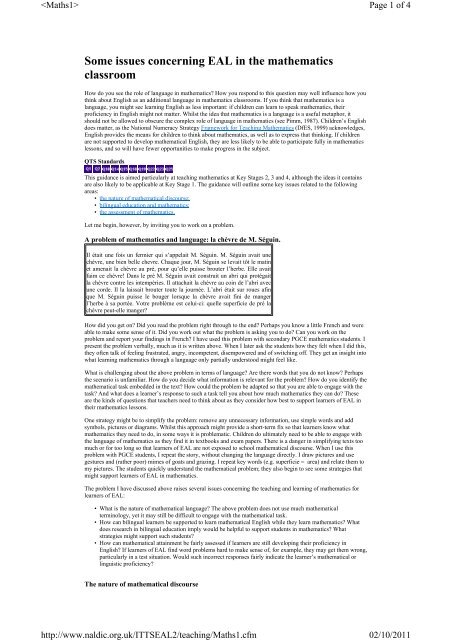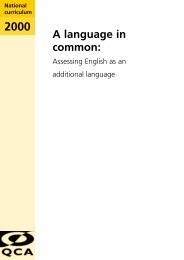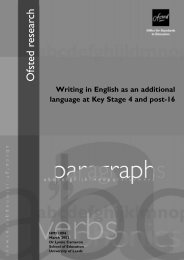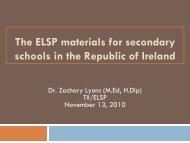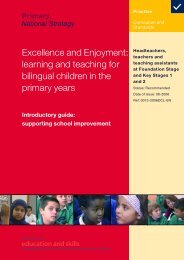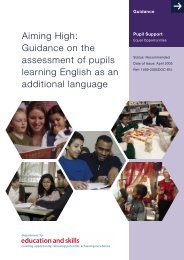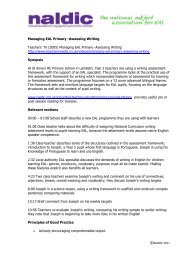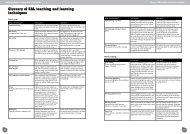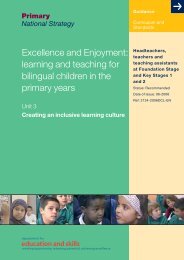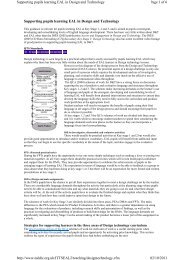Some issues concerning EAL in the mathematics classroom - NALDIC
Some issues concerning EAL in the mathematics classroom - NALDIC
Some issues concerning EAL in the mathematics classroom - NALDIC
You also want an ePaper? Increase the reach of your titles
YUMPU automatically turns print PDFs into web optimized ePapers that Google loves.
http://www.naldic.org.uk/ITTS<strong>EAL</strong>2/teach<strong>in</strong>g/Maths1.cfmPage 1 of 402/10/2011<strong>Some</strong> <strong>issues</strong> <strong>concern<strong>in</strong>g</strong> <strong>EAL</strong> <strong>in</strong> <strong>the</strong> ma<strong>the</strong>matics<strong>classroom</strong>How do you see <strong>the</strong> role of language <strong>in</strong> ma<strong>the</strong>matics? How you respond to this question may well <strong>in</strong>fluence how youth<strong>in</strong>k about English as an additional language <strong>in</strong> ma<strong>the</strong>matics <strong>classroom</strong>s. If you th<strong>in</strong>k that ma<strong>the</strong>matics is alanguage, you might see learn<strong>in</strong>g English as less important: if children can learn to speak ma<strong>the</strong>matics, <strong>the</strong>irproficiency <strong>in</strong> English might not matter. Whilst <strong>the</strong> idea that ma<strong>the</strong>matics is a language is a useful metaphor, itshould not be allowed to obscure <strong>the</strong> complex role of language <strong>in</strong> ma<strong>the</strong>matics (see Pimm, 1987). Children’s Englishdoes matter, as <strong>the</strong> National Numeracy Strategy Framework for Teach<strong>in</strong>g Ma<strong>the</strong>matics (DfES, 1999) acknowledges,English provides <strong>the</strong> means for children to th<strong>in</strong>k about ma<strong>the</strong>matics, as well as to express that th<strong>in</strong>k<strong>in</strong>g. If childrenare not supported to develop ma<strong>the</strong>matical English, <strong>the</strong>y are less likely to be able to participate fully <strong>in</strong> ma<strong>the</strong>maticslessons, and so will have fewer opportunities to make progress <strong>in</strong> <strong>the</strong> subject.QTS StandardsThis guidance is aimed particularly at teach<strong>in</strong>g ma<strong>the</strong>matics at Key Stages 2, 3 and 4, although <strong>the</strong> ideas it conta<strong>in</strong>sare also likely to be applicable at Key Stage 1. The guidance will outl<strong>in</strong>e some key <strong>issues</strong> related to <strong>the</strong> follow<strong>in</strong>gareas:• <strong>the</strong> nature of ma<strong>the</strong>matical discourse;• bil<strong>in</strong>gual education and ma<strong>the</strong>matics;• <strong>the</strong> assessment of ma<strong>the</strong>matics.Let me beg<strong>in</strong>, however, by <strong>in</strong>vit<strong>in</strong>g you to work on a problem.A problem of ma<strong>the</strong>matics and language: la chèvre de M. Ségu<strong>in</strong>.Il était une fois un fermier qui s’appelait M. Ségu<strong>in</strong>. M. Ségu<strong>in</strong> avait unechèvre, une bien belle chevre. Chaque jour, M. Ségu<strong>in</strong> se levait tôt le mat<strong>in</strong>et amenait la chèvre au pré, pour qu’elle puisse brouter l’herbe. Elle avaitfaim ce chèvre! Dans le pré M. Ségu<strong>in</strong> avait construit un abri qui protégaitla chèvre contre les <strong>in</strong>tempéries. Il attachait la chèvre au co<strong>in</strong> de l’abri avecune corde. Il la laissait brouter toute la journée. L’abri était sur roues af<strong>in</strong>que M. Ségu<strong>in</strong> puisse le bouger lorsque la chèvre avait f<strong>in</strong>i de mangerl’herbe à sa portée. Votre problème est celui-ci: quelle superficie de pré lachèvre peut-elle manger?How did you get on? Did you read <strong>the</strong> problem right through to <strong>the</strong> end? Perhaps you know a little French and wereable to make some sense of it. Did you work out what <strong>the</strong> problem is ask<strong>in</strong>g you to do? Can you work on <strong>the</strong>problem and report your f<strong>in</strong>d<strong>in</strong>gs <strong>in</strong> French? I have used this problem with secondary PGCE ma<strong>the</strong>matics students. Ipresent <strong>the</strong> problem verbally, much as it is written above. When I later ask <strong>the</strong> students how <strong>the</strong>y felt when I did this,<strong>the</strong>y often talk of feel<strong>in</strong>g frustrated, angry, <strong>in</strong>competent, disempowered and of switch<strong>in</strong>g off. They get an <strong>in</strong>sight <strong>in</strong>towhat learn<strong>in</strong>g ma<strong>the</strong>matics through a language only partially understood might feel like.What is challeng<strong>in</strong>g about <strong>the</strong> above problem <strong>in</strong> terms of language? Are <strong>the</strong>re words that you do not know? Perhaps<strong>the</strong> scenario is unfamiliar. How do you decide what <strong>in</strong>formation is relevant for <strong>the</strong> problem? How do you identify <strong>the</strong>ma<strong>the</strong>matical task embedded <strong>in</strong> <strong>the</strong> text? How could <strong>the</strong> problem be adapted so that you are able to engage with <strong>the</strong>task? And what does a learner’s response to such a task tell you about how much ma<strong>the</strong>matics <strong>the</strong>y can do? Theseare <strong>the</strong> k<strong>in</strong>ds of questions that teachers need to th<strong>in</strong>k about as <strong>the</strong>y consider how best to support learners of <strong>EAL</strong> <strong>in</strong><strong>the</strong>ir ma<strong>the</strong>matics lessons.One strategy might be to simplify <strong>the</strong> problem: remove any unnecessary <strong>in</strong>formation, use simple words and addsymbols, pictures or diagrams. Whilst this approach might provide a short-term fix so that learners know whatma<strong>the</strong>matics <strong>the</strong>y need to do, <strong>in</strong> some ways it is problematic. Children do ultimately need to be able to engage with<strong>the</strong> language of ma<strong>the</strong>matics as <strong>the</strong>y f<strong>in</strong>d it <strong>in</strong> textbooks and exam papers. There is a danger <strong>in</strong> simplify<strong>in</strong>g texts toomuch or for too long so that learners of <strong>EAL</strong> are not exposed to school ma<strong>the</strong>matical discourse. When I use thisproblem with PGCE students, I repeat <strong>the</strong> story, without chang<strong>in</strong>g <strong>the</strong> language directly. I draw pictures and usegestures and (ra<strong>the</strong>r poor) mimes of goats and graz<strong>in</strong>g. I repeat key words (e.g. superficie = area) and relate <strong>the</strong>m tomy pictures. The students quickly understand <strong>the</strong> ma<strong>the</strong>matical problem; <strong>the</strong>y also beg<strong>in</strong> to see some strategies thatmight support learners of <strong>EAL</strong> <strong>in</strong> ma<strong>the</strong>matics.The problem I have discussed above raises several <strong>issues</strong> <strong>concern<strong>in</strong>g</strong> <strong>the</strong> teach<strong>in</strong>g and learn<strong>in</strong>g of ma<strong>the</strong>matics forlearners of <strong>EAL</strong>:• What is <strong>the</strong> nature of ma<strong>the</strong>matical language? The above problem does not use much ma<strong>the</strong>maticalterm<strong>in</strong>ology, yet it may still be difficult to engage with <strong>the</strong> ma<strong>the</strong>matical task.• How can bil<strong>in</strong>gual learners be supported to learn ma<strong>the</strong>matical English while <strong>the</strong>y learn ma<strong>the</strong>matics? Whatdoes research <strong>in</strong> bil<strong>in</strong>gual education imply would be helpful to support students <strong>in</strong> ma<strong>the</strong>matics? Whatstrategies might support such students?• How can ma<strong>the</strong>matical atta<strong>in</strong>ment be fairly assessed if learners are still develop<strong>in</strong>g <strong>the</strong>ir proficiency <strong>in</strong>English? If learners of <strong>EAL</strong> f<strong>in</strong>d word problems hard to make sense of, for example, <strong>the</strong>y may get <strong>the</strong>m wrong,particularly <strong>in</strong> a test situation. Would such <strong>in</strong>correct responses fairly <strong>in</strong>dicate <strong>the</strong> learner’s ma<strong>the</strong>matical orl<strong>in</strong>guistic proficiency?The nature of ma<strong>the</strong>matical discourse
http://www.naldic.org.uk/ITTS<strong>EAL</strong>2/teach<strong>in</strong>g/Maths1.cfmPage 2 of 402/10/2011Ma<strong>the</strong>matical discourse has a number of dist<strong>in</strong>ctive features, <strong>in</strong>clud<strong>in</strong>g some aspects which are particular toma<strong>the</strong>matics <strong>classroom</strong>s.Ma<strong>the</strong>matical discourse has a specialist ma<strong>the</strong>matical vocabulary, which <strong>in</strong>cludes:• technical terms specific to ma<strong>the</strong>matics (e.g. equilateral, quotient, probability);• specialist use of more general terms (e.g. l<strong>in</strong>e, factor, frequency);• ma<strong>the</strong>matical terms that use everyday words used for unrelated ideas (e.g. function, expression, difference,area).Students learn<strong>in</strong>g <strong>EAL</strong> need to learn relevant ma<strong>the</strong>matical vocabulary (see <strong>the</strong> NNS booklet Ma<strong>the</strong>maticalVocabulary for a list). In <strong>the</strong> above problem, <strong>the</strong> word ‘superficie’ (area) is clearly important. Learners of <strong>EAL</strong> mayalso need to appreciate how ma<strong>the</strong>matical term<strong>in</strong>ology relates to everyday usage. Strategies might <strong>in</strong>cludevocabulary match<strong>in</strong>g activities; use of word lists and dictionaries; provid<strong>in</strong>g plenty of opportunities for students touse words <strong>in</strong> spoken and written form.Ma<strong>the</strong>matical discourse <strong>in</strong>cludes specialist syntax, particularly <strong>in</strong> relation to <strong>the</strong> expression of logical relationships.Thus <strong>the</strong> use of and, of, or, a, if and <strong>the</strong>n to def<strong>in</strong>e ma<strong>the</strong>matical relationships are all significant. Such words, are,however, easy to overlook. Strategies to support <strong>the</strong> development of syntax could <strong>in</strong>clude <strong>the</strong> use of writ<strong>in</strong>g framesor partly structured sentences (e.g. match<strong>in</strong>g a set of ‘if’ clauses with a set of ‘<strong>the</strong>n’ clauses).Ma<strong>the</strong>matical discourse <strong>in</strong>volves <strong>the</strong> use of ma<strong>the</strong>matical symbols. Such symbols range from numerals to morespecialised notation. These symbols have a syntax of <strong>the</strong>ir own, so 2x and mean different th<strong>in</strong>gs. Aga<strong>in</strong>,match<strong>in</strong>g tasks could support <strong>the</strong> connection of symbols with <strong>the</strong> related words.Ma<strong>the</strong>matical discourse <strong>in</strong>cludes specialised ways of talk<strong>in</strong>g, <strong>in</strong>clud<strong>in</strong>g written and spoken forms of ma<strong>the</strong>maticalexplanation, proof or def<strong>in</strong>ition, as well as text types like word problems. These broader ways of us<strong>in</strong>g language areimportant <strong>in</strong> express<strong>in</strong>g ma<strong>the</strong>matical ideas and reason<strong>in</strong>g. Strategies for support<strong>in</strong>g <strong>the</strong> development ofma<strong>the</strong>matical ways of talk<strong>in</strong>g have to <strong>in</strong>volve creat<strong>in</strong>g rich opportunities for students to expla<strong>in</strong> <strong>the</strong>ir th<strong>in</strong>k<strong>in</strong>g. Thus,structured pair or group work is likely to be supportive.F<strong>in</strong>ally, <strong>in</strong> <strong>classroom</strong>s, ma<strong>the</strong>matical discourse also <strong>in</strong>cludes a social dimension: <strong>the</strong> particular ways that studentsand teachers talk <strong>in</strong> ma<strong>the</strong>matics classes that are not specifically ma<strong>the</strong>matical, but that are associated withma<strong>the</strong>matics. Instructions, for example, might <strong>in</strong>clude expressions like ‘simplify’ or ‘complete <strong>the</strong> follow<strong>in</strong>g’.Teachers often use ‘we’ to refer to ‘people who do ma<strong>the</strong>matics’ (e.g. we use x to represent an unknown). And wordproblems, like <strong>the</strong> example above, are to be <strong>in</strong>terpreted <strong>in</strong> a way that is specific to ma<strong>the</strong>matics lessons.A range of useful examples of activities that support language development <strong>in</strong> relation to different aspects ofma<strong>the</strong>matical discourse with<strong>in</strong> ma<strong>the</strong>matics teach<strong>in</strong>g can be found <strong>in</strong> both Access and Engagement <strong>in</strong> Ma<strong>the</strong>matics(DfES, 2002), and <strong>in</strong> Secondary Ma<strong>the</strong>matics and English as an Additional Language (Driver, 2005) (See alsoMonaghan, 2000; Leung, 2005)Bil<strong>in</strong>gual education and ma<strong>the</strong>maticsIn <strong>the</strong> section on bil<strong>in</strong>gualism and second language acquisition Charlotte Franson highlights 5 key research f<strong>in</strong>d<strong>in</strong>gs<strong>concern<strong>in</strong>g</strong> <strong>the</strong> education of bil<strong>in</strong>gual learners <strong>in</strong> ma<strong>in</strong>stream <strong>classroom</strong>s. These po<strong>in</strong>ts can be related morespecifically to ma<strong>the</strong>matics:Po<strong>in</strong>t 1: The learner’s first or home language plays a significant role <strong>in</strong> <strong>the</strong> learn<strong>in</strong>g of <strong>the</strong> second language <strong>in</strong> termsof cognitive, l<strong>in</strong>guistic and socio-cultural <strong>in</strong>fluences.This po<strong>in</strong>t provides an argument for try<strong>in</strong>g to f<strong>in</strong>d ways to <strong>in</strong>corporate <strong>the</strong> use of students’ home languages <strong>in</strong>toma<strong>the</strong>matics lessons. Strategies might <strong>in</strong>clude students work<strong>in</strong>g with same-language partners for some of <strong>the</strong> time;<strong>in</strong>vit<strong>in</strong>g parents to participate <strong>in</strong> ma<strong>the</strong>matics lessons from time to time; work<strong>in</strong>g with bil<strong>in</strong>gual colleagues; us<strong>in</strong>gbil<strong>in</strong>gual dictionaries and o<strong>the</strong>r resources. The National Numeracy Strategy Framework for Teach<strong>in</strong>g Ma<strong>the</strong>matics(DfES, 1999) encourages some of <strong>the</strong>se ideas, such, as for example, <strong>the</strong> <strong>in</strong>vestigation of number systems <strong>in</strong> differentlanguages.Po<strong>in</strong>t 2: Bil<strong>in</strong>gual education can be very beneficial <strong>in</strong> <strong>the</strong> development of <strong>the</strong> second language.This po<strong>in</strong>t follows on from <strong>the</strong> previous one and suggests that by support<strong>in</strong>g students to develop <strong>the</strong> ma<strong>the</strong>maticalaspects of <strong>the</strong>ir home language is likely to have a positive effect on <strong>the</strong>ir ma<strong>the</strong>matical English. For example, <strong>in</strong>Access and Engagement <strong>in</strong> Ma<strong>the</strong>matics (DfES, 2002), Vasant Mahandru describes how he uses duallanguageTurkish-English loop cards as part of his oral and mental starter strategies to support learners’ engagementwith and use of ma<strong>the</strong>matical def<strong>in</strong>itions.Po<strong>in</strong>t 3: Most <strong>EAL</strong> and bil<strong>in</strong>gual learners will develop a functional level of English <strong>in</strong> <strong>the</strong> first two years ofschool<strong>in</strong>g <strong>in</strong> English but <strong>the</strong>y will need cont<strong>in</strong>ued support to develop <strong>the</strong> cognitive academic language proficiencynecessary for academic success.This po<strong>in</strong>t implies that ma<strong>the</strong>matics teachers should not assume that a student who appears to communicateeffectively <strong>in</strong> ‘everyday’ English will have <strong>the</strong> necessary proficiency to communicate at <strong>the</strong> same level <strong>in</strong>ma<strong>the</strong>matics. The demands of ma<strong>the</strong>matical English are higher than those of everyday English and students mayneed to be support to develop <strong>the</strong> necessary proficiency. In <strong>the</strong> word problem given above, for example, even if youhave some understand<strong>in</strong>g of French, you might have found <strong>the</strong> ma<strong>the</strong>matical language unfamiliar. You might be ableto work on <strong>the</strong> problem, but not have enough proficiency <strong>in</strong> ma<strong>the</strong>matical French to report your f<strong>in</strong>d<strong>in</strong>gs. An outl<strong>in</strong>eof <strong>the</strong> nature of ma<strong>the</strong>matical language is given above. Strategies might <strong>in</strong>clude <strong>the</strong> use of writ<strong>in</strong>g frames, match<strong>in</strong>gcards, dictionaries and word lists as well as explicit discussion of ma<strong>the</strong>matical language. Driver (2005) suggests awide range of strategies, <strong>in</strong>clud<strong>in</strong>g, for example, a match<strong>in</strong>g activity, <strong>in</strong> which learners match algebraic expressionswith equivalent l<strong>in</strong>guistic expressions (e.g.might be matched with ‘n-squared’ or ‘n multiplied by n’).
http://www.naldic.org.uk/ITTS<strong>EAL</strong>2/teach<strong>in</strong>g/Maths1.cfmPage 3 of 402/10/2011Po<strong>in</strong>t 4: Learn<strong>in</strong>g a second language will not necessarily proceed <strong>in</strong> an orderly and systematic fashion. Learners willuse prior l<strong>in</strong>guistic, learned and world knowledge, learners will learn when <strong>the</strong>re is a need to communicate and tolearn, and learners will learn when <strong>the</strong>y are motivated to learn.This po<strong>in</strong>t is equally likely to apply <strong>in</strong> ma<strong>the</strong>matics. It suggests that it is worth creat<strong>in</strong>g ma<strong>the</strong>matical situationswhich motivate students’ need to communicate <strong>the</strong>ir ideas. Strategies might <strong>in</strong>clude <strong>in</strong>struction-giv<strong>in</strong>g activities;group presentations of extended work; ma<strong>the</strong>matical newsletters featur<strong>in</strong>g students’ work; competitions.This po<strong>in</strong>t also suggests f<strong>in</strong>d<strong>in</strong>g ways to relate school ma<strong>the</strong>matics to learners’ out-of-school contexts. Those of youwho know a little about farm<strong>in</strong>g may have made more sense of <strong>the</strong> French word problem than those who do not. TheNNS Framework suggests strategies such as ask<strong>in</strong>g students to br<strong>in</strong>g and expla<strong>in</strong> ma<strong>the</strong>matical games from home.More <strong>in</strong>volved work could <strong>in</strong>clude ask<strong>in</strong>g learners to <strong>in</strong>vestigate <strong>the</strong> use of ma<strong>the</strong>matics <strong>in</strong> <strong>the</strong> home or communityand prepare a report about <strong>the</strong>ir f<strong>in</strong>d<strong>in</strong>gs. The report could be written <strong>in</strong> more than one language and could besupported by <strong>the</strong> use of writ<strong>in</strong>g frames (see Driver, 2005, Section 6 for an example).Po<strong>in</strong>t 5: Learn<strong>in</strong>g a language and becom<strong>in</strong>g bil<strong>in</strong>gual is also about learn<strong>in</strong>g and liv<strong>in</strong>g <strong>in</strong> different societies andcultures. It is not just about acquir<strong>in</strong>g a new language, but also about understand<strong>in</strong>g ano<strong>the</strong>r culture, and develop<strong>in</strong>gano<strong>the</strong>r identity.This po<strong>in</strong>t implies that bil<strong>in</strong>gual students are learn<strong>in</strong>g how to be a learner of ma<strong>the</strong>matic as much as learn<strong>in</strong>g how todo and talk about ma<strong>the</strong>matics. Their experiences of school<strong>in</strong>g and of learn<strong>in</strong>g ma<strong>the</strong>matics may be very differentfrom what <strong>the</strong>y f<strong>in</strong>d <strong>in</strong> <strong>the</strong> UK; <strong>the</strong>y may have little prior ma<strong>the</strong>matics education. Students from East Asia may beused to a formal, memory-based approach to ma<strong>the</strong>matics, for example. Learners from many communities may seema<strong>the</strong>matics as ‘right or wrong’ and ma<strong>the</strong>matics teachers as always right! These experiences may provide anuncomfortable contrast with approaches used <strong>in</strong> UK ma<strong>the</strong>matics <strong>classroom</strong>s, <strong>in</strong> which, for example, <strong>the</strong>NationalNumeracy Strategy Framework for Teach<strong>in</strong>g Ma<strong>the</strong>matics (DfES, 1999) encourages attention to a variety ofmethods and explanations, often generated by <strong>the</strong> learners. The National Curriculum <strong>in</strong>clusion statement expectsteachers to respond to <strong>the</strong> diverse needs such students may have. Such an expectation is often challeng<strong>in</strong>g, and <strong>the</strong><strong>in</strong>clusion statement offers three guid<strong>in</strong>g pr<strong>in</strong>ciples (with examples) which can be seen as a start<strong>in</strong>g po<strong>in</strong>t fordevelop<strong>in</strong>g practice:• Sett<strong>in</strong>g suitable learn<strong>in</strong>g challenges;• Respond<strong>in</strong>g to pupils’ diverse learn<strong>in</strong>g needs;• Overcom<strong>in</strong>g potential barriers to learn<strong>in</strong>g and assessment for <strong>in</strong>dividuals and groups of pupils .The assessment of ma<strong>the</strong>matics and <strong>EAL</strong>Assessment <strong>in</strong> ma<strong>the</strong>matics covers a range of approaches, from nationally set standardised tests, to teachers’judgements of atta<strong>in</strong>ment based on systematic <strong>classroom</strong> observation. Assessment of <strong>the</strong> ma<strong>the</strong>matical atta<strong>in</strong>ment oflearners of <strong>EAL</strong> is, however, highly problematic, s<strong>in</strong>ce any method of assessment relies to some extent on learners’use of English. In pr<strong>in</strong>ciple, for example, ma<strong>the</strong>matics tests and exam<strong>in</strong>ations should not be proxy tests of English. Inpractice, this pr<strong>in</strong>ciple is difficult to implement. If you were unable to tackle <strong>the</strong> problem at <strong>the</strong> top of this page, it isunlikely to have been because you were not able to do <strong>the</strong> ma<strong>the</strong>matics.One challenge for teachers of learners of <strong>EAL</strong> is to evaluate <strong>the</strong> possible demands and appropriateness of differentforms of assessment for particular learners. If such demands can be evaluated <strong>in</strong> some way, teachers will be <strong>in</strong> abetter position to make decisions about which methods to use and to develop strategies to support learners of <strong>EAL</strong>. Aframework proposed by Cumm<strong>in</strong>s (e.g. 2000, p. 68) provides a useful conceptual tool with which to tackle thischallenge. Cumm<strong>in</strong>s relates two key dimensions: (language-related) cognitive demand and (communicative) context.These two dimensions for <strong>the</strong> quadrants are shown <strong>in</strong> <strong>the</strong> section on bil<strong>in</strong>gual language acquisition . In <strong>the</strong> version,below, various forms of ma<strong>the</strong>matical assessment activity are placed with<strong>in</strong> <strong>the</strong> quadrants.It can be hypo<strong>the</strong>sised that activities <strong>in</strong> <strong>the</strong> upper right-hand corner of <strong>the</strong> diagram are likely to be more problematicfor learners of <strong>EAL</strong>, and so less reliable <strong>in</strong>dicators of <strong>the</strong>ir ma<strong>the</strong>matical capabilities. Similarly, those <strong>in</strong> <strong>the</strong> lowerleft-hand corner are likely to be more useful to teachers. Given a choice, teachers could <strong>the</strong>refore seek to develop oruse assessment methods closer to <strong>the</strong> lower left-hand corner.Unfortunately, formal ma<strong>the</strong>matics tests are widely used <strong>in</strong> <strong>the</strong> UK. Given this situation, teachers could look forways to, <strong>in</strong> effect, move methods of assessment away from <strong>the</strong> upper right-hand corner towards <strong>the</strong> centre of <strong>the</strong>diagram. For example, mental arithmetic tests provide little l<strong>in</strong>guistic context but are highly demand<strong>in</strong>g, s<strong>in</strong>ce <strong>the</strong>yrely entirely on listen<strong>in</strong>g – <strong>the</strong>re is no opportunity to <strong>in</strong>teract with <strong>the</strong> questioner. Learners could be prepared for suchtests by develop<strong>in</strong>g activities <strong>in</strong> which listen<strong>in</strong>g skills are practiced. Learners could be provided with a set ofquestions, for example, and are <strong>the</strong>n asked to identify which question is be<strong>in</strong>g orally asked.
http://www.naldic.org.uk/ITTS<strong>EAL</strong>2/teach<strong>in</strong>g/Maths1.cfmPage 4 of 402/10/2011In <strong>the</strong> national tests supervised by QCA, some modest special arrangements are permitted for learners of <strong>EAL</strong>.Provision <strong>in</strong>cludes extra time and translation (see Access Arrangements for full details of <strong>the</strong> current arrangementsfor <strong>EAL</strong> learners). The QCA website also has some relevant <strong>in</strong>formation <strong>in</strong> a section on <strong>in</strong>clusion atwww.qca.org.uk/6166.html..Contribut<strong>in</strong>g AuthorRichard BarwellReferencesCumm<strong>in</strong>s, J. 2000: Language, Power and Pedagogy: Bil<strong>in</strong>gual Children <strong>in</strong> <strong>the</strong> Crossfire. Clevedon: Multil<strong>in</strong>gualMatters.DfES (1999) National Numeracy Strategy: Framework for Teach<strong>in</strong>g Ma<strong>the</strong>matics. DfES publications.Retrieved 28thApril 2006 from http://www.standards.dfes.gov.uk/primary/publications/ma<strong>the</strong>matics/math_framework/school_organisation/938757.DfES (2000) National Numeracy Strategy: Ma<strong>the</strong>matical vocabulary. DfES publications 0313/2000). Retrieved 28thApril 2006 from http://www.standards.dfes.gov.uk/primary/publications/ma<strong>the</strong>matics/vocabulary/nns_mathvocab031300.pdfDfES, (2002) Access and Engagement <strong>in</strong> Ma<strong>the</strong>matics. DfES publications 0251/2002. Retrieved 28th April 2006from http://www.standards.dfes.gov.uk/keystage3/downloads/ma_eal.pdfDriver, C. (2005) Secondary Ma<strong>the</strong>matics and English as an additional language.Retrieved 28th April 2006 from http://www.multiverse.ac.uk/viewArticle.aspx?contentId=550Leung, C. (2005) Ma<strong>the</strong>matical vocabulary: fixers of knowledge or po<strong>in</strong>ts of exploration? Language and Education19(2) 127-135Monaghan, F. (2000) What difference does it make? Children's views of <strong>the</strong> differences between some quadrilaterals.Educational Studies <strong>in</strong> Ma<strong>the</strong>matics 42, 179-196.Pimm, D. (1987): Speak<strong>in</strong>g ma<strong>the</strong>matically: language <strong>in</strong> ma<strong>the</strong>matics <strong>classroom</strong>s London:Routledge.Fur<strong>the</strong>r read<strong>in</strong>gBarwell, R. (2002) Understand<strong>in</strong>g <strong>EAL</strong> <strong>issues</strong> <strong>in</strong> ma<strong>the</strong>matics. In Leung, C. (Ed.) Language and Second/AdditionalLanguage Issues for School Education: A Reader for Teachers, pp. 69-80. Watford: <strong>NALDIC</strong> Publications Group.Barwell, R. (2002) Whose words? Ma<strong>the</strong>matics Teach<strong>in</strong>g 178, 34-36.Barwell, R. (2001) Learn<strong>in</strong>g from listen<strong>in</strong>g: talk <strong>in</strong> a multil<strong>in</strong>gual ma<strong>the</strong>matics <strong>classroom</strong>. <strong>NALDIC</strong> OccasionalPaper 14. Watford: <strong>NALDIC</strong> Available from <strong>NALDIC</strong> publications.Barwell, R., Leung, C., Morgan, C. and Street, B. (2002) The Language dimension of ma<strong>the</strong>matics teach<strong>in</strong>g.Ma<strong>the</strong>matics Teach<strong>in</strong>g 180, 12-15.Durk<strong>in</strong>, K. and Shire, B. (Eds.) (1991) Language <strong>in</strong> Ma<strong>the</strong>matical Education Buck<strong>in</strong>gham: Open University Press.Emblen, V. (1988) Asian Children <strong>in</strong> Schools In Pimm, D. (Ed.): Ma<strong>the</strong>matics,Teachers and Children, pp. 82-94London: Hodder and Stoughton.Gibbs, W. and Orton, J. (1994) Language and Ma<strong>the</strong>matics. In Orton, A. and Wa<strong>in</strong>, G. (Eds.): Issues <strong>in</strong> Teach<strong>in</strong>gMa<strong>the</strong>matics London: Cassell.Jones, D.V. (1998) National Curriculum Tests for Ma<strong>the</strong>matics <strong>in</strong> English and Welsh: creat<strong>in</strong>g matched assessments.Assessment <strong>in</strong> Education 5( 2) 193-211.Lev<strong>in</strong>e, J. (Ed.) (1990) Bil<strong>in</strong>gual Learners and <strong>the</strong> Ma<strong>in</strong>stream Curriculum. Brighton: Falmer.Monaghan, F. (1999) Def<strong>in</strong><strong>in</strong>g a role: <strong>the</strong> <strong>EAL</strong> teacher <strong>in</strong> maths. <strong>NALDIC</strong> Occasional Paper 12. Watford: <strong>NALDIC</strong>.Available from <strong>NALDIC</strong> publications.Scarcella, R. (1990) Teach<strong>in</strong>g Language M<strong>in</strong>ority Students <strong>in</strong> <strong>the</strong> Multi-L<strong>in</strong>gual Classroom. London: Prentice HallRegents.Copyright <strong>NALDIC</strong> 2011


